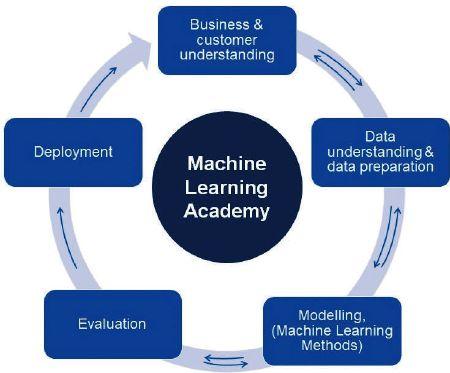
4 minute read
Analyzing energy consumption using flow sensors
Figure: The cyclic nature of artificial intelligence and machine learning (AI/ML) projects, as presented in Dimecc’s Machine Learning Academy. Courtesy: Dimecc Ltd.
the most important things are to ensure versatile education will be available, investments are made in new education methods and programs are created to attract talent to Finland. Continuous education of employees is a challenge, and different operations and mechanisms can address the concerns. A critical factor is to increase management awareness and knowledge regarding the AI opportunities, to secure enough input for new flexible education methods.
Advertisement
AI employee competence requirements
Employee competence requirements are affected by the changes in the work demand in the job markets. The need for new talent is increasing at a rapid pace in tasks where AI will be developed and applied. This demand cannot be addressed by the usual education path. New operations and mechanisms are needed to help improve existing employee skills efficiently.
Much of the employee competencies are based on the on-the-job learning, so companies have more responsibility for competence development. Companies actively seek ways to re-educate employees internally or in co-operation with other companies.
There are numerous approaches exist to educate, but little workplace learning in Industry 4.0 contexts exist. Organizations need an adequate performance appraisal strategy and adequate workforce training with self-regulated, reflective, collaborative and blended learning to lower risk of excluding workers from Industry 4.0 environments. Organizations without adequate training risk impacts on production efficiency, product diversity and quality.
Companies need to equip existing professionals with the AI skills to apply their knowledge in the AIdriven world. This is supported by a 2018 study of Future Workplace and The Learning House, which highlights that training the workforce for AI and ML skills could be the efficient way to fill the skills gap.
Letmathe & Schinner (2017) state the success of workers will depend on flexibility and problem-solving competencies as well as willingness to engage in lifelong learning; otherwise workers will be unable to keep up with the required changes in their workplaces and work procedures. This challenge also might explain why many companies are reluctant to invest in cyber-physical systems (CPS), which often includes AI. Competence management on the organizational level, as well as the reform of public education, are important factors for introducing CPS.
Case study: Machine learning classes
Free and general-level online training on AI and ML is available from major technology providers (such as IBM, Microsoft, Amazon and Google) or from MOOCs organized by prominent universities.
An example is “Elements of AI,” a 6-module online course created in co-operation by the Finnish technology company Reaktor Ltd. and the University of Helsinki. Typically, the aim of this type of training is “to demystify AI” to encourage a broad group of people to learn what AI is, what is it good for and what are its limitations.
Machine Learning Academy (MLA) from Dimecc Ltd. in co-operation with Futurice Ltd., is a focused and industry-tailored approach for closing or at least narrowing the AI competence gap. The first course focused on the Finnish machine manufacturing industry in fall 2018. The second course closed at the end of April 2019. This initiative was also highlighted in the final report of Finland’s National AI Programme as an innovative example of AI-related education.
MLA’s primary target audience consists of research and development (R&D) supervisors and engineers as well as business and product owners who are managing and/or participating in AI/ML development projects. To succeed in these tasks, they need to understand how to specify, plan, evaluate and manage development or insourcing of sub-entities that contain elements of AI and ML. For example, for R&D engineers, it is important to understand how introduction of these new technologies will change the capabilities, boundaries, schedules and interfaces of their product development processes. After the course, participants will have an understanding of the fundamentals of AI and ML as well as an ability to recognize and manage development tasks that aim to benefit from use of these new methodologies.
MLA consists of seven full-day training modules with supporting pre-reading materials, handson exercises and homework. The training starts with high-level topics, such as reviewing typical business drivers and examples of ML applications.
In the more technical modules, ML methodologies are covered (supervised learning, unsupervised learning and deep learning), followed by data understanding and ethics of AI. The sixth module helps the participants understand how real-life AI/ML projects are executed. The last module reviews course projects.
Throughout the course various types of business and technical canvases are introduced and used as learning tools. Their main purpose is to help the participants understand where they need to focus and which stakeholders they need to engage with during the different phases of data science projects. For example, the “Business Objective and Context” canvas used in the first module directs its users to work together with business owners and those who fund the project when answering questions such as:








